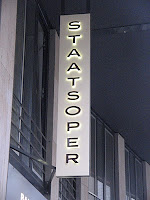 A few days ago I mentioned my fear that Rheingold might be set in a wind farm. That wasn’t just being clever. When you go to the opera in Germany, one thing you won’t see is a traditional production. Every town has its own opera theatre, and the audience has seen every work a zillion times, so they want something a bit different. The start of this tendency has been attributed to Patrice Chereau’s Ring cycle at Bayreuth in 1976, when the first scene of Rheingold took place at a hydroelectric dam.
A few days ago I mentioned my fear that Rheingold might be set in a wind farm. That wasn’t just being clever. When you go to the opera in Germany, one thing you won’t see is a traditional production. Every town has its own opera theatre, and the audience has seen every work a zillion times, so they want something a bit different. The start of this tendency has been attributed to Patrice Chereau’s Ring cycle at Bayreuth in 1976, when the first scene of Rheingold took place at a hydroelectric dam. No power plants of any sort in Hamburg’s first scene – we got a bedroom! The three little Rhinemaidens were having a pajama party in a great bed, when Alberich the gardener, looking a little like Bill Bailey, sees them through the window while he is spraying pesticide. The little vixens start flirting with him, he tries to get off with them. In an egregiously tedious piece in the program book,* the director Claus Guth says that elements of this production were inspired by some of his experiences as a boy. This was obviously from the ‘Penthouse letters behind D-Block’ stage, but instead of ‘wocka-wocka’ guitar we get the Philharmoniker Hamburg. The girls are just teasing, he gets cranky, and runs off with the Rhinegold.
Scene 2 takes place in Wotan’s house, the ‘Attic of the World’ according to Guth. Does your attic have a large rock in the middle of it? Wotan’s does.
The rest of the opera has more of the same. Not sure what Guth’s overall concept is, or if he has one, but it all had a strange sort of logic which worked. Loge (Jurgen Sächer), who everyone makes a point of saying is a trickster, performs magic tricks. He enters wearing a top hat, cane and gold sparkly jacket, like an escapee from the Folies Bergere – a couple of times he twirled, but didn’t start tapping. (I instantly thought of An American in Paris– ‘I’ll build a stairway to paradise…’). There were many touches like this that demonstrated that Guth wasn’t trying to show off but does know how to tell a story. While it didn’t work all the time, his direction kept things moving so it never gets boring. (A treacherous admission for a Wagnerite to make, but if Homer merely nods, Wagner has the occasional nanna-nap.)
Falk Struckmann (Wotan) sang acceptably all night, but seems to be saving himself for Sunday night’s Die Walküre. Both the giants looked handsome (trust me, that’s an innovation) and sang well instead of barking their parts. Tigran Martirossian’s Fasolt was lyrical and moving, and Freia was believable when she almost fell for him. Alexander Tsymbalyuk (Fafner) has a rich bass which makes me look forward to when he turns into a dragon (part three, on Wednesday night). For me the star was Wolfgang Koch (Alberich), who always found the musical line, and delivered ‘Bin ich nun frei?’ with a creepy malevolence and beautiful tone.
The prelude started in complete darkness, the famous E flat emerging from the primordial depths, but what should be one of the really magical moments in all of opera was accompanied by a coughing obbligato which made me think we were back in Sydney. The Staatsoper has a wonderful acoustic, everything in balance and projecting well to the back of the house. Simone Young had the orchestra playing well, bringing out the chamber-music elements of the music that Pierre Boulez found but keeping the textures full (so it sounded like an orchestra, not a string quartet). We noticed two things in the curtain calls:
1. The Hamburgers love Simone.
2. She was wearing flatties (we think), a sign that she is getting sensible (once we saw her conduct Meistersinger in stilettos).
For the record the ring itself is a bracelet which looks a bit like a fat gold Rolex.
*In German; I gave up after the first page.

No comments:
Post a Comment